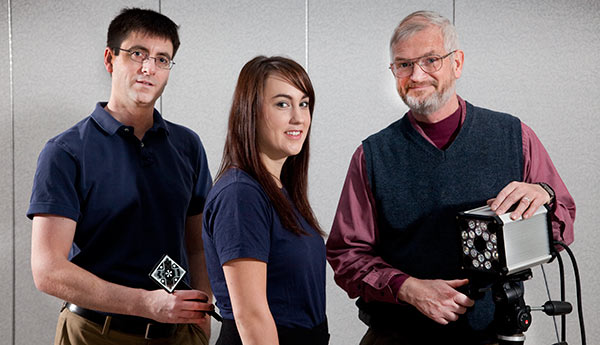
Magnetic resonance imaging (MRI) is a powerful diagnostic tool, but because the patient must remain completely still during the scan, the technology can be challenging to use with children and patients who are disabled.
A motion detection system co-developed by UWM engineering professor Brian Armstrong can help address that problem. His system produces accurate measurements of movements, and can be used to correct the motion of patient movements that could otherwise ruin the medical image.
Motion correction for MRI could reduce the need to sedate children for medically necessary scans, creating a safer and less expensive process, Armstrong says. It also could eventually be used for research in brain development.
Armstrong has been involved with efforts to commercialize motion-detection equipment through Metria Innovation Inc., a startup firm in Wauwatosa that launched in 2008 to commercialize this novel motion-tracking technology.
It is one of six startup companies that have evolved from UWM research.
The system he helped to create, called moiré phase tracking, incorporates a motion-tracking marker and a single camera. The system makes use of a phenomenon you may have noticed on silk or satin fabric when darker shaded swaths appear as one layer of fabric shifts in front of another. Called moiré patterns, these occur when light passes through two overlapping weaves.
The moiré patterns of a Metria motion-tracking marker are a highly engineered phenomenon. “Moiré patterns amplify the optical effect of angles, permitting accurate measurement in each image,” says Randy Holl, an adviser to Metria Innovation and CIO of Contact Solutions, Inc.
“From each image we can very accurately detect the orientation of the motion-tracking marker,” adds Armstrong. “For motion tracking, software interprets the changing moiré patterns, yielding an exact location of the tagged part of the body. The imaging process moves continuously with the subject.”
The researchers spent years making the process faster and more reliable. In 2007, it took about eight seconds to process an image. Today the moiré phase tracking system can process more than 100 images per second.
Moiré phase tracking technology is being targeted to researchers and research laboratories. It is already in use at seven scanning facilities around the world. Armstrong and Kristian O’Connor, chair of UWM’s kinesiology department, are also working to apply moiré phase tracking to the analysis of human movement during walking. Gait is affected by such conditions as knee and hip injuries, arthritis and orthopedic surgery.
Since 2006, O’Connor and Armstrong have won two grants from both the National Institutes of Health and UWM’s Research Growth Initiative to develop the technology, supporting UWM graduate students and moving the technology closer to being a useful tool for analysis of human gait. O’Connor and Armstrong are currently working on an SBIR Phase II proposal to continue this work.
The UWM Research Foundation has licensed two patents-pending to Metria Innovation. One provides an opportunity to further optimize the motion tracking marker, and the other involves using a ceramic element to reduce vibration in cameras that are used to track motion in a MRI scanner. The ceramic camera is already in practical use.







